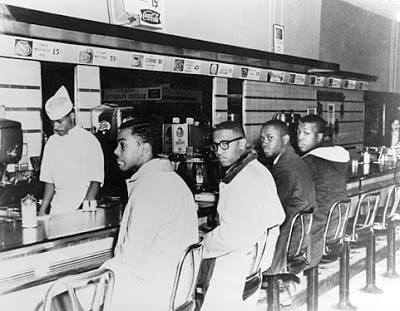From the Digital Crate: "What if the Greensboro Four had Twitter?"

From the Digital Crate: What If theGreensboro Four Had Twitter? by Mark Anthony Neal | NewBlackMan
February1st marks the anniversary of what I like to refer to as one of thegreatest days in American History. On that day in 1960, four young Black men—Joseph McNeil, Franklin McCain, Ezell Blair,Jr., and David Richmond—all first year students at HBCU North Carolina A&T,sat at a Whites only lunch counter at a Woolworth's department store in Greensboro, North Carolina.
Thisprotest—formally known as a sit-in—began weeks of similar protests, that wentviral throughout the American South in ways that mirror the functions of today'ssocial media. The Greensborosit-ins are widely remembered as the moment of activism that gave renewedenergy and vigor to a Civil Rights Movement that was sputtering after thesuccess of the Montgomery Bus Boycott.
TheGreensboro Four, of course, did not have access to social media such as Twitterand Facebook, but nevertheless utilized what would have been the accessibletechnology of the days like land-lines, good-old fashion word of mouth, andwhat was really the cutting edge technology of the day: a mimeograph machine. Those young folk, who would monthsafter Greensboro, go on to create the Student Non-Violent CoordinatingCommittee (SNCC), under the watchful eye of Ella Jo Baker, understoodtechnology, including television, as simply one of the tools they employed tomake their case.
CivilRights activist brilliantly exploited television cameras, helping to bring themarches in the streets straight into the living rooms of average Americans,whether they wanted to see it or not. Many activists from the era point to the role that televised footage ofyoung Black Americans being hosed down and attacked by police dogs played ingenerating sympathy for a nation that had been largely indifferent.
Thespirit of the Civil Rights Movement of the early 1960s and the role thattechnology played during that time has been recalled in the last year withregards to the Georgia Prison Strike, the Arab Spring, the #Occupy Movement andthe State murder of Troy Davis.
Whereasprisoners in Georgia State prisons used disposable cell phones to organize non-violentprotest via text messaging, Twitter and Facebook have been critical tools forthe largely young folks taking to the streets in the Middle East. In these cases, the ruling governmentsresponded by shutting down internet access and eventually cell phone andtraditional land-line coverage when protestors resorted to old-school forms ofcommunication.
AmongBlack social media users in the United States, Twitter and Facebook wereutilized by those who createdon-line petitions to protest an Ohio court decision to convict Kelly Williams-Bolarof "fraud" in response to her attempt to establish a second residency in abetter school district for her two daughters, as was also the case with thehighly visible efforts to save Troy Davis' life The efforts among, Black "digital natives" and "digitalimmigrants" (like myself) mirror recent advocacy efforts for the Jena 6, theScott Sisters, and Haitian Earthquake relief—efforts that challenge perceptionsthat social media only has amind-numbing effect on young people.
Recallingthe efforts in support of Williams-Bolar, critic and scholar Kyra D. Gaunt acknowledged that "Twittercame along it felt like a change to me." Still it's important to remember that, Social Media is simply a toolthat connects to the long established human desire to resist oppression andsuppression.
Asyoung folk, in particular, find more innovative and effective forms of SocialMedia, there will be those who seek to co-opt it for other designs. 50 years ago, Black radio was animportant cog in the ability for organizers to get their message out to theBlack masses, yet one would be hard pressed to think of Radio One—the largestBlack-owned radio company—playing such a role in this environment.
Asthe events quickly unfold throughout the world, it will become clear that many arelooking at Social Media in a new light, whether its Twitter, Facebook or thememories of four young men sitting at a lunch counter in Greensboro, NC.
***
Mark Anthony Neal is the author of five books including the forthcoming Looking for Leroy: (Il)Legible Black Masculinities (New York University Press) and Professor of African & African-American Studies at Duke University. He is founder and managing editor of NewBlackMan and host of the weekly webcast Left of Black . Follow him on Twitter @NewBlackMan.
Published on February 01, 2012 06:12
No comments have been added yet.
Mark Anthony Neal's Blog
- Mark Anthony Neal's profile
- 30 followers
Mark Anthony Neal isn't a Goodreads Author
(yet),
but they
do have a blog,
so here are some recent posts imported from
their feed.



